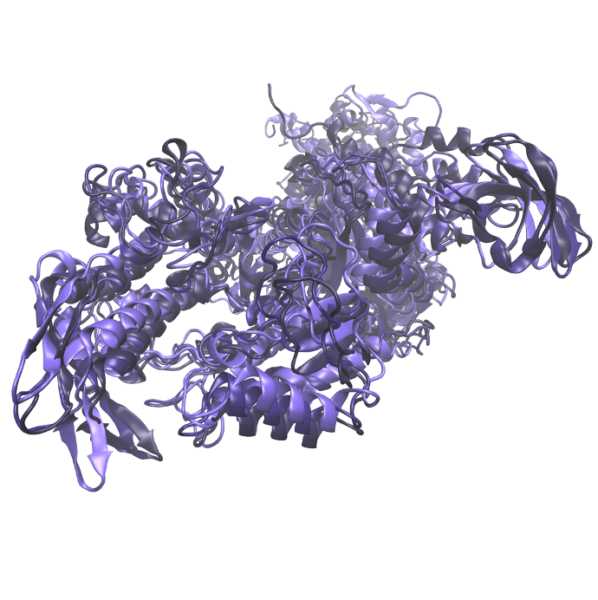Data from: Multiscale Modeling Shows How 2'-deoxy-ATP Rescues Ventricular Function in Heart Failure
Data from: Multiscale Modeling Shows How 2'-deoxy-ATP Rescues Ventricular Function in Heart Failure
About this collection
- Extent
-
1 digital object.
- Cite This Work
-
Teitgen, Abigail E.; Hock, Marcus T.; McCabe, Kimberly J.; Childers, Matthew C.; Huber, Gary A.; Marzban, Bahador; Beard, Daniel A.; McCammon, J. Andrew; Regnier, Michael; McCulloch. Andrew D. (2024). Data from: Multiscale Modeling Shows How 2'-deoxy-ATP Rescues Ventricular Function in Heart Failure. UC San Diego Library Digital Collections. https://doi.org/10.6075/J00G3KCC
- Description
-
This collection contains the molecular dynamics simulations of the myosin motor protein from the PNAS paper "Multiscale modeling shows how 2'-deoxy-ATP rescues ventricular function in heart failure". The molecular dynamics simulations were carried in triplicate out with either ATP (ADP.Pi) bound to the pre-powerstroke scallop myosin (PDB: 1QVI), or dATP (dADP.Pi) for 2 microseconds. The simulations were carried out to understand how dATP influences myosin structure and function, and acts as a possible heart failure therapeutic. The uploaded trajectories include the topology file for the ATP and dATP structures, with frames saved every 10 ps. The explicit water has been removed from the simulations in order to save space. Please see the manuscript for a complete description of the molecular dynamics simulations carried out.
These trajectories are also used as inputs to create molecular Markov State models, to discretize the conformations of myosin into distinct metastable states. This analysis is carried out in python Jupyter notebooks, in the github associated with the manuscript and this collection. - Creation Date
- 2020 to 2022
- Date Issued
- 2024
- Authors
- Contributor
- Funding
-
Simulations carried out with compute time resources provided by Extreme Science and Engineering Discovery Environment (XSEDE) resource COMET through allocation TG-MCB200100 (to M.R.). XSEDE was supported by the National Science Foundation grant number ACI-1548562.
This work was supported by National Institutes of Health grants GM31749 (to G.A.H.), HL154624 (to D.A.B.), HL128368 and P30 AR074990 (to M.R.), HL137100 (to A.D.M.) and P41 GM103426 (to A.D.M. and J.A.M.) and Wu Tsai Human Performance Alliance and the Joe and Clara Tsai Foundation (to A.D.M.). This material is based upon work supported by the National Science Foundation Graduate Research Fellowship Program under Grant No. DGE-2038238 (to A.E.T.), the UC President's Dissertation Year Fellowship (to A.E.T.), and an American Heart Association Pre-doctoral Fellowship award ID 906494 (to M.T.H.). Partial funding for M.C.C. was provided by Award Number T32HL007828 from the National Heart, Lung, and Blood Institute. K.J.M. is supported by the Simula-UCSD-University of Oslo Research and Ph.D. training (SUURPh) program, an international collaboration in computational biology and medicine funded by the Norwegian Ministry of Education and Research. - Scientific Name
- Topics
Format
View formats within this collection
- Language
- English
- Identifier
-
Identifier: Abigail E. Teitgen: https://orcid.org/0000-0002-5134-7261
Identifier: Andrew D. McCulloch: https://orcid.org/0000-0002-1708-5675
Identifier: Bahador Marzban: https://orcid.org/0000-0002-0724-7749
Identifier: Daniel A. Beard: https://orcid.org/0000-0003-0974-2353
Identifier: Gary A. Huber: https://orcid.org/0000-0002-5936-6184
Identifier: J. Andrew McCammon: https://orcid.org/0000-0003-3065-1456
Identifier: Kimberly J. McCabe: https://orcid.org/0000-0001-9153-8313
Identifier: Marcus T. Hock: https://orcid.org/0000-0001-6071-5655
Identifier: Matthew C. Childers: https://orcid.org/0000-0003-2440-9612
Identifier: Michael Regnier: https://orcid.org/0000-0001-5437-9851
- Related Resources
- Teitgen, Abigail E., Marcus T. Hock, Kimberly J. McCabe, Matthew C. Childers, Gary A. Huber, Bahador Marzban, Daniel A. Beard, J. Andrew McCammon, Michael Regnier, Andrew D. McCulloch. "Multiscale modeling shows how 2’-deoxy-ATP rescues ventricular function in heart failure." Proceedings of the National Academy of Sciences 121 (July 22, 2024). https://doi.org/10.1073/pnas.2322077121
- GitHub Code used to analyze the molecular dynamics data, and construct Markov State models, as well as subsequent multiscale models. https://github.com/cmrg-lab/dATP_multiscale_modeling
- Zenodo release of Github code used to analyze the molecular dynamics data, and construct Markov State models, as well as subsequent multiscale models. Code for "Multiscale Modeling Shows How 2'-deoxy-ATP Rescues Ventricular Function in Heart Failure", 2024. marcushock, & abbyteitgen11. (2024). cmrg-lab/dATP_multiscale_modeling: v1.0.0 (v1.0.0). Zenodo. https://doi.org/10.5281/zenodo.13137395
- Visualization can be carried out with the VMD molecular graphics viewer: https://www.ks.uiuc.edu/Research/vmd/
- Visualization can be carried out with UCSF Chimera: https://www.cgl.ucsf.edu/chimera/
- Image credit. Marcus Hock. "Conformational States of Prepowerstroke Myosin."
Primary associated publication
Software
Referenced by
Other resource
Collection image
 Library Digital Collections
Library Digital Collections
